Speed is a game-changer in the world of sports. It’s the secret weapon that can turn an average athlete into a standout performer. In this article, we’ll delve into the multifaceted significance of greater speed in sports performance, exploring how it impacts various aspects of an athlete’s game and crucially the 7 most effective exercises to help build strength and increase speed.
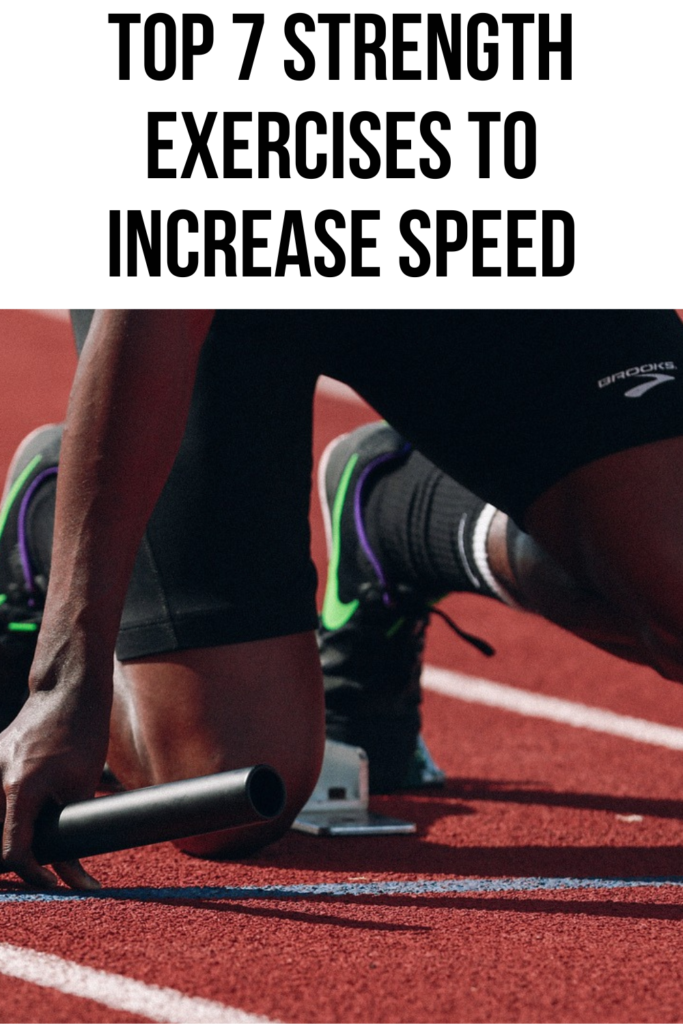
Introduction
Speed is crucial factor in sports if you want to dominate your opposition, and it’s no secret that top athletes possess exceptional strength. Scientific research has highlighted the importance of building strength to handle significant forces for achieving greater speed. Renowned speed and strength coach, Ferris Con, has shared seven powerful strength exercises designed to enhance both strength and speed. In this blog post, we’ll delve into each exercise, detailing their benefits and how to perform them effectively.
8 Benefits of speed
- Competitive Edge and Dominance: Speed is a fundamental attribute that sets athletes apart from their competitors. Whether it’s a sprinter surging ahead on the track or a soccer player beating defenders to score, speed provides a distinct advantage. Athletes with superior speed have the ability to dominate their opponents, making them formidable contenders in any sporting event.
- Enhanced Reaction Time: Speed isn’t just about running fast; it’s about reacting quickly to the demands of the game. Athletes with greater speed exhibit faster reflexes, enabling them to respond swiftly to changing situations. This heightened reaction time is particularly crucial in sports like tennis, football, and basketball, where split-second decisions can determine the outcome.
- Acceleration and Explosiveness: Acceleration, the ability to reach top speed rapidly, is a cornerstone of many sports. Athletes with exceptional acceleration can seize opportunities and break away from opponents. Explosiveness, another key element of speed, enables athletes to generate sudden bursts of energy, crucial for activities like jumping, sprinting, and changing direction.
- Reduced Injury Risk: Counterintuitively, speed training can actually reduce the risk of certain injuries. When an athlete’s body is conditioned for speed, it becomes more resilient to sudden changes in movement and direction. Additionally, speed-focused training often includes exercises that enhance flexibility and agility, contributing to overall injury prevention.
- Strategic Advantage: Speed can be a powerful tactical tool in sports. Athletes with exceptional speed force opponents to adjust their strategies. In team sports, a player with superior speed can disrupt defensive formations, create scoring opportunities, and cover ground swiftly on both offense and defense.
- Psychological Impact: Speed can be a psychological weapon, instilling fear and uncertainty in opponents. Knowing they’re up against a fast athlete can make opponents second-guess their decisions and actions. This psychological edge can lead to tactical advantages and give the speedy athlete a mental edge.
- Versatility and Adaptability: Speed is a versatile asset that transcends specific sports. Athletes with speed can transition between different disciplines more easily. For example, a track athlete with exceptional speed may find it easier to excel in other sports like football or rugby, where speed is highly valued.
- Improved Conditioning and Endurance: Speed training demands a high level of cardiovascular and muscular endurance. By incorporating speed-focused exercises into their training regimen, athletes improve their overall conditioning. This translates to increased stamina and endurance, which are crucial for maintaining performance levels throughout a game or event.
Greater speed isn’t just about crossing the finish line first; it’s about transforming an athlete’s overall performance. It’s the catalyst for dominance, the key to split-second decision-making, and the foundation for strategic play.
Through dedicated training and focused conditioning, athletes can tap into the immense potential that speed brings to their game. So, whether on the track, field, or court, speed remains the ultimate game-changer in sports performance.
7 Effective Exercises to Boost Speed and Strength
- Single Leg Squats for Explosive Strength
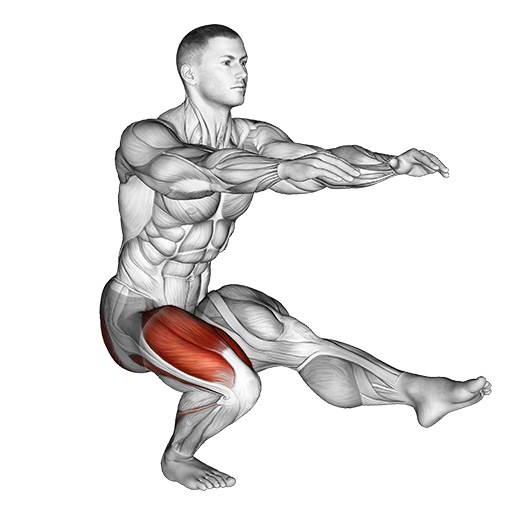
Single leg squats are a foundational exercise for developing strength and explosiveness. The key to maximizing their effectiveness for speed development lies in focusing on specific aspects of strength training.
By incorporating a controlled eccentric phase and explosive concentric phase, you can target the glutes and build the necessary power for speed. Aim for 4-5 sets of 2-3 reps with a 3-second eccentric phase for an effective workout.
This exercise primarily targets muscles in your lower body, including the quadriceps, hamstrings, glutes, and calf muscles. It also engages stabilizing muscles around the ankle, knee, and hip joints, enhancing your overall stability and coordination.
Performing single-leg squats can help identify and correct strength imbalances between your legs. This promotes more symmetrical strength development and reduces the risk of injuries.
Additionally, single-leg squats improve flexibility and mobility in the hip, knee, and ankle joints. The exercise mimics natural movements like walking, climbing stairs, or standing up from a seated position, making it highly functional for daily activities.
Engaging your core is essential during single-leg squats to maintain balance. This results in improved core strength, which is crucial for stability in various movements.
To get started, stand on one leg with the other extended in front of you. Lower your body by bending the knee of the supporting leg, while keeping your chest up and back straight. Maintain control and balance throughout the movement, and push through the heel of the supporting leg to return to the starting position.
Remember to begin with bodyweight-only single-leg squats and progress gradually as your strength and stability improve. Maintaining proper form is crucial to prevent injuries, so focus on controlled movements and increase the difficulty level over time.
- Staggered Stance Trap Bar Deadlifts for Unilateral Loading
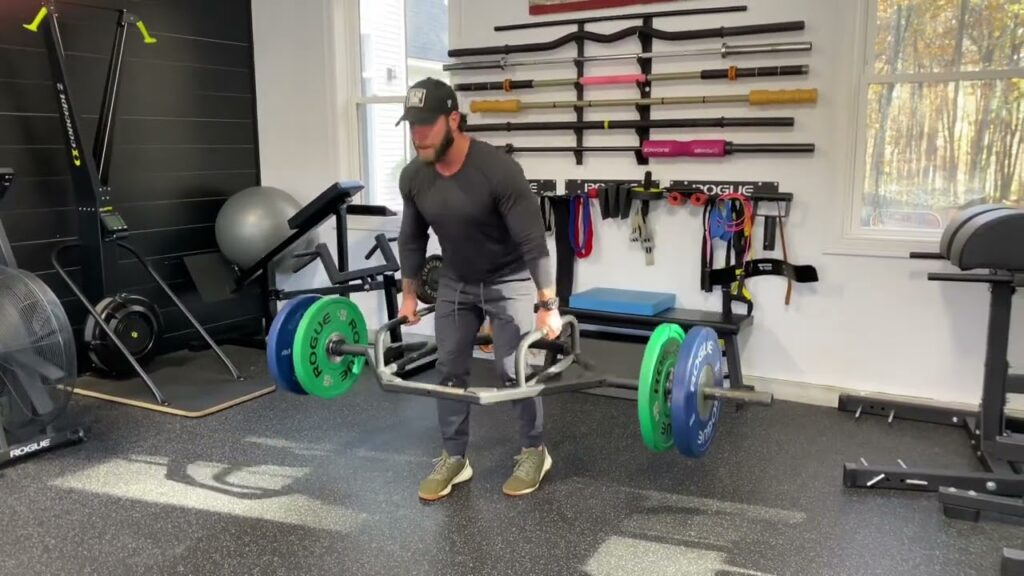
The staggered stance trap bar deadlift is a powerful exercise that combines lower body development with unilateral loading. This exercise places most of the weight on the front foot while utilizing the back leg for stabilization. It engages the quads, hamstrings, and glutes extensively. Aim for 3-4 sets of 3-4 reps per side, adjusting the weight based on your comfort level.
This exercise primarily targets the posterior chain, including the glutes, hamstrings, lower back, and traps. By incorporating a staggered stance, you emphasize one leg’s contribution to the lift, helping to identify and correct any strength imbalances between your legs.
Staggered stance trap bar deadlifts also place less stress on the lower back compared to the conventional deadlift, making it a suitable option for individuals with lower back concerns. The trap bar allows for a more upright torso position, reducing forces on the spine.
The staggered stance provides a more natural and functional movement pattern, as it mimics how we often move in daily activities or sports. This exercise helps improve overall balance and stability, which is particularly valuable for athletes who require precise control in their movements.
To perform the staggered stance trap bar deadlift, set up with one foot slightly behind the other and grab the handles of the trap bar. Keep your chest up, engage your core, and push through the heels to lift the bar off the ground. Maintain a smooth and controlled motion throughout the lift, and then slowly lower the bar back down.
Start with lighter weights and gradually increase the load as you become more comfortable with the exercise. Focus on maintaining proper form and control, ensuring that both legs are actively engaged in the movement.
- Low Pin Squats for Enhanced Hip Strength
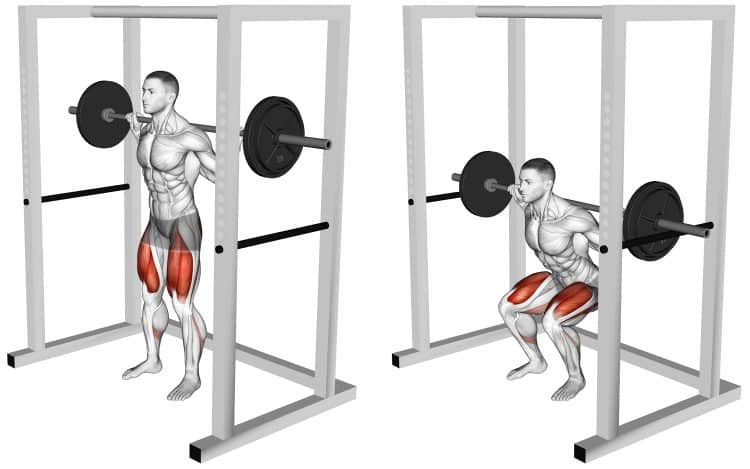
Low pin squats target the weak points in your range of motion and focus on developing hip strength. This exercise is particularly beneficial for rugby players, offensive and defensive linemen, as well as shot putters and swimmers. By starting from pins and performing a driving squat, you can effectively work on explosive strength. Incorporate auditory commands to simulate reactive scenarios, making it highly specific to game situations.
This exercise is highly effective for targeting specific portions of the squat, particularly the bottom portion where you might struggle with strength or technique. By starting from a lower position, low pin squats help to build strength in the range of motion that is typically the most challenging for many lifters.
One of the key benefits of low pin squats is the ability to focus on form and technique without the need to worry about the initial lift-off from the bottom. This can be particularly useful for individuals who have difficulty with the initial phase of the squat or for those recovering from injuries.
Low pin squats can also be beneficial for powerlifters and athletes looking to improve their squat performance. By isolating and strengthening the specific portion of the lift where they may struggle, they can potentially see improvements in their overall squat numbers.
- Hand Supported Single Leg Romanian Deadlifts for Stability and Strength
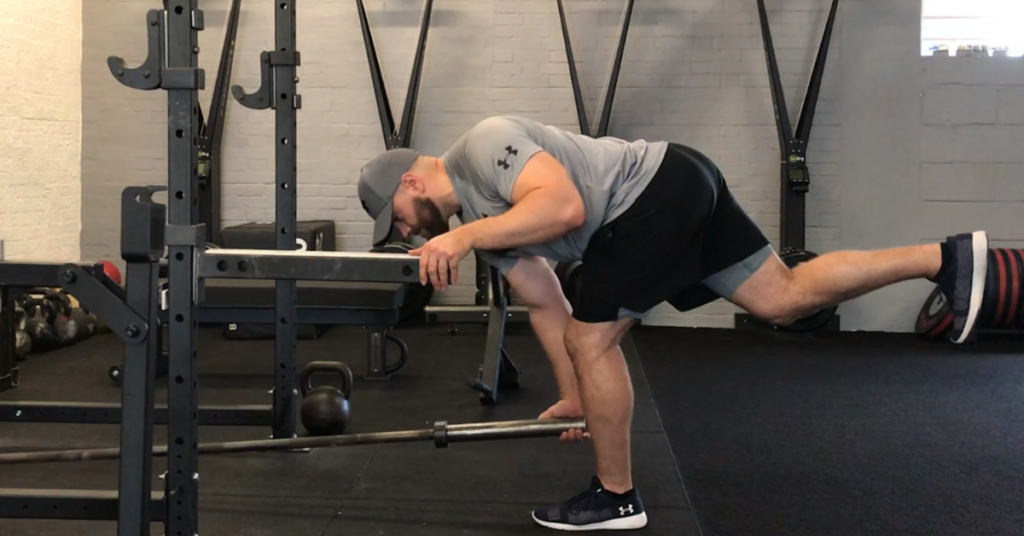
The hand-supported single-leg Romanian deadlift is excellent for building unilateral strength while providing stability. This exercise targets the hamstrings and lower back, areas crucial for sprinting and speed development. By using a controlled eccentric phase and an explosive concentric phase, you can effectively enhance strength and stability. Aim for 3-4 sets of 6-8 reps per side, adjusting the weight as needed.
The movement begins by standing on one leg with a slight bend in the knee. The hand on the same side as the supporting leg holds onto a stable surface, such as a bench, rack, or any sturdy object. From this position, the free leg is extended straight behind, forming a straight line with the torso.
As you hinge at the hips, the upper body lowers toward the ground, maintaining a neutral spine. The non-working leg and the upper body should move in unison, staying in alignment. The goal is to lower the torso until it’s parallel to the ground or until a comfortable stretch is felt in the hamstrings.
Throughout the movement, it’s crucial to engage the core and maintain a controlled descent. The emphasis should be on feeling a deep stretch in the hamstrings, rather than touching the ground. The glutes of the supporting leg should be actively engaged to stabilize the body.
To return to the starting position, push through the heel of the supporting leg and engage the glutes and hamstrings. The free leg should be lifted back up, bringing the body back to a fully upright position.
Hand supported single-leg Romanian deadlifts are excellent for improving balance, stability, and unilateral strength. They also help to develop flexibility in the hamstrings and improve hip mobility. Additionally, this exercise engages the stabilizing muscles of the core, making it a valuable addition to any lower body or full-body workout routine.
- Sprinter Glute Ham Raises for Targeted Hamstring Strength
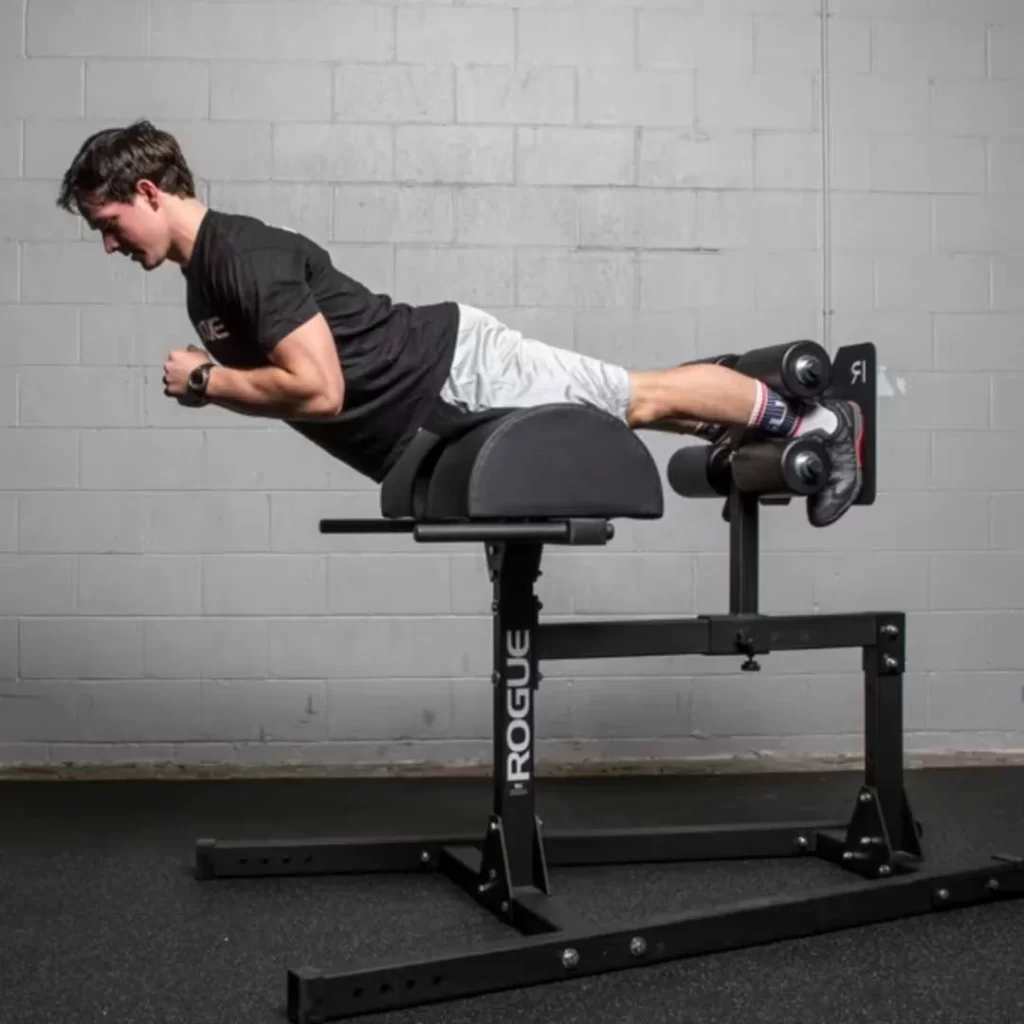
The sprinter glute ham raise is a specialized exercise that isolates the hamstrings. It replicates the specific mechanics of sprinting, making it an invaluable addition to a speed-focused workout routine. Focus on a controlled descent and explosive return to the starting position. Aim for 3-4 sets of 7 reps per side, starting with your weaker leg.
To perform the sprinter glute ham raise, you’ll need a glute-ham developer (GHD) machine. Begin by securing your feet beneath the footpads, with your body positioned face-down and your knees slightly bent. Keep your torso straight and your hands placed on your hips or at your sides.
From this starting position, lower your upper body towards the ground while maintaining a controlled motion. As you descend, you should feel a stretch in your hamstrings. Once you’ve reached a comfortable limit, use your hamstring and glute strength to push yourself back up to the starting position.
What sets the sprinter variation apart is the added element of knee flexion. As you rise up, concentrate on flexing your knees, mimicking the action of the leg during the acceleration phase of a sprint. This engages the hamstrings even more intensely, making it an excellent exercise for athletes looking to improve their sprinting power.
Performing sprinter glute ham raises regularly can help strengthen the specific muscles involved in sprinting, contributing to improved acceleration and speed.
- Sled Marches for Explosive Lower Body Power
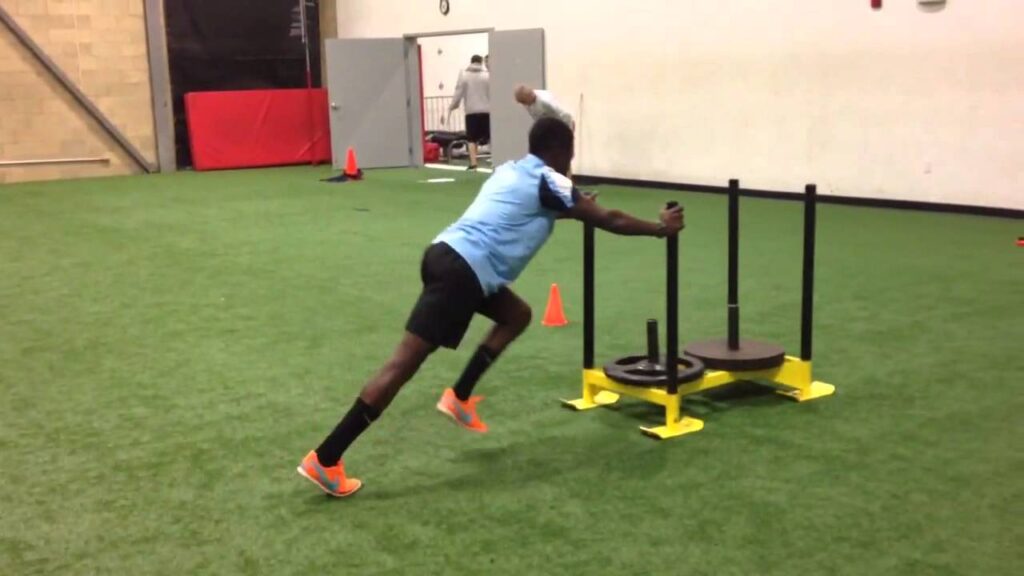
Sled marches are an exceptional exercise for building explosive lower body power. Load the sled with 30-40% of your body weight and maintain a 45° angle while marching. This mimics the acceleration phase of sprinting, making it highly specific. Aim for 6 sets of 20 yards, ensuring each step is powerful and explosive.
To perform sled marches, you’ll need access to a sled and a harness or handles to grasp onto. Begin by attaching the harness or handles securely to your body. Position yourself in front of the sled, with your feet shoulder-width apart and your knees slightly bent. Maintain a 45° torso angle, engage your core, and keep your chest lifted.
As you start walking forward, focus on driving through your legs and pushing the ground away from you. The sled will offer resistance, intensifying the effort required from your leg muscles. It’s crucial to maintain a controlled stride, avoiding any excessive swaying or jerking motions.
Sled marches are an excellent exercise for athletes looking to build lower body strength, power, and endurance. They closely mimic the mechanics of activities like sprinting, making them especially beneficial for sports that require explosive movements and rapid acceleration.
By incorporating sled marches into your training regimen, you can specifically target the muscles used in activities like running, sprinting, and jumping. This can lead to improvements in speed, agility, and overall athletic performance.
- Nordic Hamstring Curls for Eccentric Strength
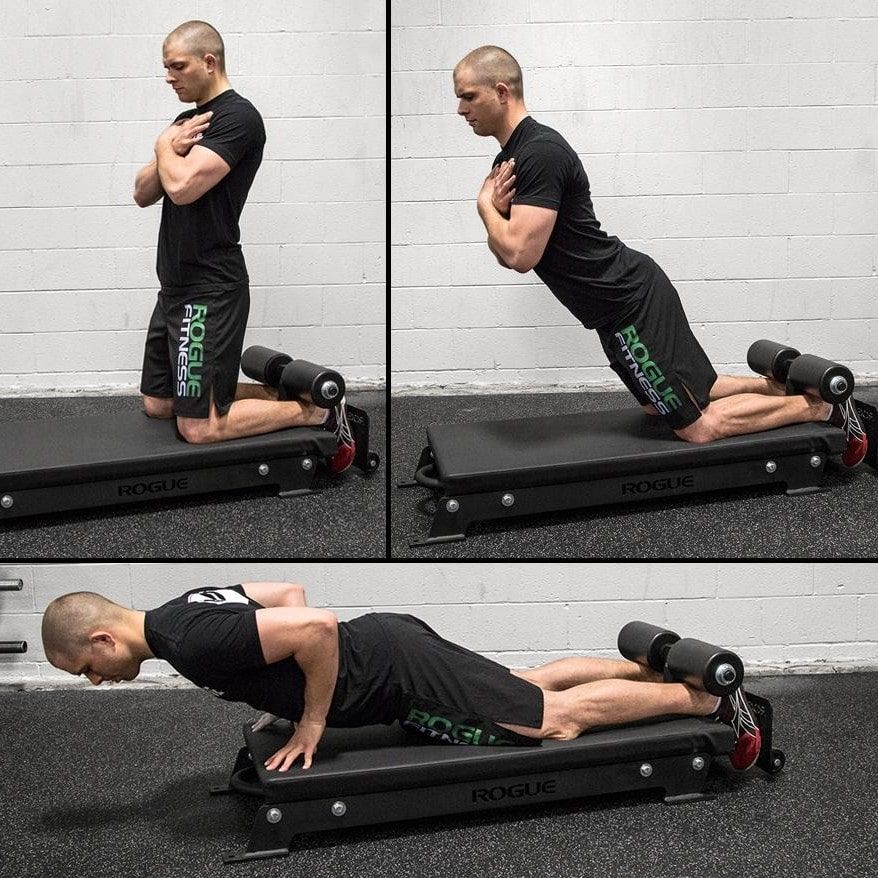
The Nordic hamstring curl is a phenomenal exercise for eccentric hamstring strength. It emphasizes the controlled lengthening of the hamstring, which is vital for deceleration and speed development. It’s a challenging exercise, so start with regressions if needed. Aim for 3-4 sets of 5-7 reps, incorporating a drop set of 10-12 reps for an added challenge.
To perform a Nordic hamstring curl, you’ll need a partner or an anchor to secure your feet. Kneel on a soft surface, tucking your feet under the anchor. Engage your core and maintain a straight line from your knees to your head. Slowly lower your upper body forward, maintaining control as your body approaches the ground. The movement focuses on the hamstrings working to control the descent.
Nordic hamstring curls are particularly valuable for athletes seeking to enhance their hamstring strength, which plays a crucial role in various athletic activities like running, jumping, and cutting movements. Strong hamstrings contribute to improved speed, power, and injury prevention.
Regularly incorporating Nordic curls into your training regimen can lead to better overall hamstring development and help correct any imbalances between the quadriceps and hamstring muscles. It’s important to start with a manageable range of motion and gradually progress to avoid straining the muscles.
Conclusion
By integrating these seven carefully selected strength exercises into your training routine, you’re setting yourself up for a noticeable boost in speed and a marked improvement in your overall athletic performance.
It’s paramount, though, to keep in mind that form should always take precedence over sheer intensity. Begin at a level that aligns with your current abilities, and steadily ramp up the challenge as you grow more proficient.
What sets these exercises apart is their targeted approach to key muscle groups, with a particular emphasis on both the eccentric and concentric phases of movement.
This deliberate focus allows you to cultivate the precise strength needed to drive yourself towards faster speeds. Remember, it’s not just about exerting force, but about controlling it with finesse.
Consistency in practice is your steadfast companion on this journey to enhanced speed. Through dedicated, regular effort, you’ll witness remarkable progress and find yourself achieving new heights of velocity in your athletic endeavors.
So, lace up those shoes, hit the gym, and prepare to witness your speed skyrocket!
Affiliate link disclosure: most of my blogs include affiliate links. When you click an affiliate link, I may receive a commission for any products or services you purchase through that link. It doesn’t cost you anything extra, and in some cases, you may receive a discount through my links. All my opinions are 100% honest, and you are welcome to purchase things by finding them on your browser instead of my links. Thank you for supporting the blog!

Pingback: Unleashing Strength: The Conjugate Powerlifting Method Explored - Universal Perspective
Pingback: Get Your Lift on Point: Choosing the Right Weightlifting Shoes - Universal Perspective